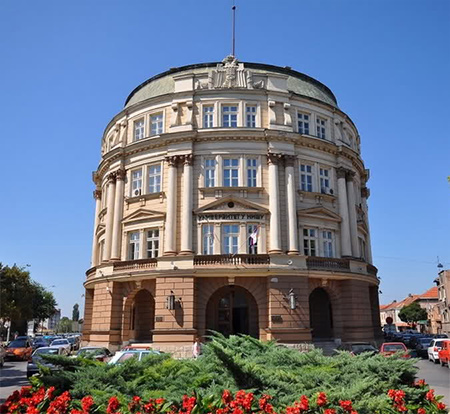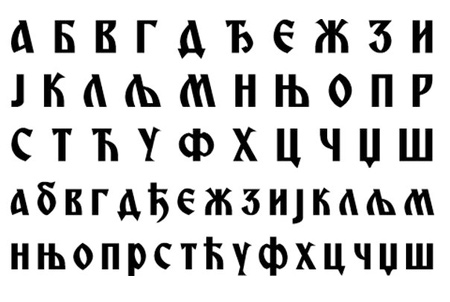
Summer school location
RECTORATE BUILDING, THE CITY OF NIS, SERBIA: Univerzitetski trg 2, 18 000 Nis
Target group
Students curious about other cultures (students of Slavic studies, of various philologies, descendants of Serbian diaspora in Germany, serbophiles, young open-minded people...)
What is included in the Summer School fee?
Board and lodging, tuition and study materials, welcome package, use of University library, wireless internet, excursions and social activities.
ECTS points available?
No. A university certificate will be issued.
Total number of participants
20 minimum. The Summer School might be cancelled if fewer than 20 participants applied.
Participation of local students
Yes
Application deadline
Dead-line for German students applying for a DAAD scholarship: 01/06/2017
Early bird registration: 20/06/2017
Dead-line: 01/08/2017
Which application forms should be submitted?
- Application form (download application form (.doc))
- CV (brief)
- Motivation letter (one page)
- Health insurance covering the whole period
Certificates
English language competence b2 certificate recommended
Please note
Information on this website is subject to change.
 The summer school LEARNING CYRILLIC: A BRIEF MULTIDISCIPLINARY APPROACH TO SERBIAN CULTURE will be organised by the University of Nis, Serbia. The University of Nis comprises 13 faculties in all fields of study including various philologies (Serbian, English, Russian, French, and soon to start German) and the summer school is designed as multidisciplinary; therefore it will be hosted by the rector’s office and not located at any of the faculties. The venue will be Room 8 well equipped and comfortable for group work. The organisers will be the vice-rector for international relations, Dr.Vesna Lopicic, and the coordinator of the Students Career Centre, Nevena Mitic, with the administrative support of the staff employed at the rector’s office. The school will be realised by the university teachers coming from different areas relevant for the content of the school.
The summer school LEARNING CYRILLIC: A BRIEF MULTIDISCIPLINARY APPROACH TO SERBIAN CULTURE will be organised by the University of Nis, Serbia. The University of Nis comprises 13 faculties in all fields of study including various philologies (Serbian, English, Russian, French, and soon to start German) and the summer school is designed as multidisciplinary; therefore it will be hosted by the rector’s office and not located at any of the faculties. The venue will be Room 8 well equipped and comfortable for group work. The organisers will be the vice-rector for international relations, Dr.Vesna Lopicic, and the coordinator of the Students Career Centre, Nevena Mitic, with the administrative support of the staff employed at the rector’s office. The school will be realised by the university teachers coming from different areas relevant for the content of the school.
The basic aim of the summer school is to teach the participants the Cyrillic script. Namely, the Cyrillic script is used in a number of Slavic countries (Belarus, Bulgaria, Kazakhstan, Kyrgyzstan, Macedonia, Mongolia, Tajikistan, Ukraine, and Russia). However, Serbia, Bosnia and Herzegovina, and Montenegro are the only countries which are characterised by active digraphia, meaning that both the Cyrillic and the Latin scripts are actively used by the Serbs living there. This curiosity has always been fascinating to foreign visitors who are puzzled by the ability of the Serbian people to switch easily between these two scripts, whether when reading or writing. Everybody reads and writes both alphabets. Cyrillic is studied in the first grade of elementary school (age 7) and children can start using it within weeks. Latin alphabet is studied in the second grade (age 8). Cyrillic is considered standard and traditional alphabet and is officially preferred.
Latin alphabet is widely used but that depends on context. Our goal is to teach the attendees the Cyrillic script and to show them the correlation between the Cyrillic and Latin scripts. This is not a difficult goal because the Serbian language has a rare feature, in that words are spelled as they are spoken, and every letter represents one sound. In fact, this is not the attribute of the language itself, but the attribute of orthography which was reformed by Vuk Karadžić. He laid the foundation for the Serbian language in the 19th c and is still famous for his precept "Write as you speak, read as it is written." Karadžić reformed the Serbian literary language and standardised the Serbian Cyrillic alphabet by following strict phonemic principles and thus created Serbian as a language with a highly phonemic orthography. As a consequence, Serbian may be described as having regular spelling. The participants will therefore learn the Cyrillic script, the corresponding Latin version of orthography, and the spelling. By the end of the two-week course they will be able to read fluently and to write a dictation in the Cyrillic alphabet. However, they will be instructed only in the basics of the Serbian grammar.
 The broader goal of the summer school LEARNING CYRILLIC: A BRIEF MULTIDISCIPLINARY APPROACH TO SERBIAN CULTURE is to familiarise the participants with various aspects of the Serbian culture. The idea is to offer interesting educative insights into ten different cultural aspects of Serbia, especially in the south: archaeology, history, cuisine, folklore, religion, customs, art, humour, literature, and sports. The southern part of Serbia, with the city of Nis as its centre and the population of about two million people, is considered specific in many different ways, especially in comparison to the cultural milieu north of Belgrade. The aim of the summer school is to show the students the cultural variety that exists in Serbia, and to contribute to the decentralisation of culture in the country. Foreign visitors as a rule visit Belgrade and Novi Sad, while Nis with a number of significant summer festivals (Nishville Jazz Festival, National Film Festival, Student Drama Festival, Choir Festival etc.) is still on the margins. By bringing foreign students to this part of Serbia we plan to establish better links between the University of Nis and other universities the participants will come from.
The broader goal of the summer school LEARNING CYRILLIC: A BRIEF MULTIDISCIPLINARY APPROACH TO SERBIAN CULTURE is to familiarise the participants with various aspects of the Serbian culture. The idea is to offer interesting educative insights into ten different cultural aspects of Serbia, especially in the south: archaeology, history, cuisine, folklore, religion, customs, art, humour, literature, and sports. The southern part of Serbia, with the city of Nis as its centre and the population of about two million people, is considered specific in many different ways, especially in comparison to the cultural milieu north of Belgrade. The aim of the summer school is to show the students the cultural variety that exists in Serbia, and to contribute to the decentralisation of culture in the country. Foreign visitors as a rule visit Belgrade and Novi Sad, while Nis with a number of significant summer festivals (Nishville Jazz Festival, National Film Festival, Student Drama Festival, Choir Festival etc.) is still on the margins. By bringing foreign students to this part of Serbia we plan to establish better links between the University of Nis and other universities the participants will come from.
Finally, the promotion of southern Serbia with its well-known warm-hearted mentality is supposed to break the negative stereotypes about Serbs still persisting in some areas. Created by the media propaganda during the recent civil wars in the region of former Yugoslavia, the prejudices against Serbia have had a very harmful effect on the image of its people. We believe that if students have their personal experience of Serbia and Serbs, they may form their own opinions and attitudes irrespective of prevalent stereotypes. This will definitely bring young people of Germany, Serbia and other countries closer together to the benefit of all. The students of the University of Nis, especially the Erasmus Student Network of Nis with its buddy section, will be actively involved in all activities of the summer school, especially in the extracurricular visits, excursions, and thematic parties.
Daily programme pattern
The daily pattern is fixed: after breakfast the students meet at the University Building, Room 8, at 10.00. Two blocks of lectures are followed by lunch at 13.30. The first block is always on various aspects of Cyrillic (10.00-11.30) while the second block explores one of the cultural aspects (12.00-13.30). A refreshment break is in-between (11.30-12.00). After lunch, there is an excursion or visit organised for all participants at 16.00. Dinner is at 19.00 and cultural programme and thematic parties come after it.
On Saturday 02/09/2017 a whole-day excursion to Belgrade will be organised with visits to the city highlights.
The Sunday 03/09/2017 will be a free day for all participants.
Download programme (.pdf)
Contact person
Vesna Lopičić
Univerzitet u Nišu, Univerzitetski trg 2, 18 000 Nis, Serbia
+381 63 86 654 85; +381 18 257 950